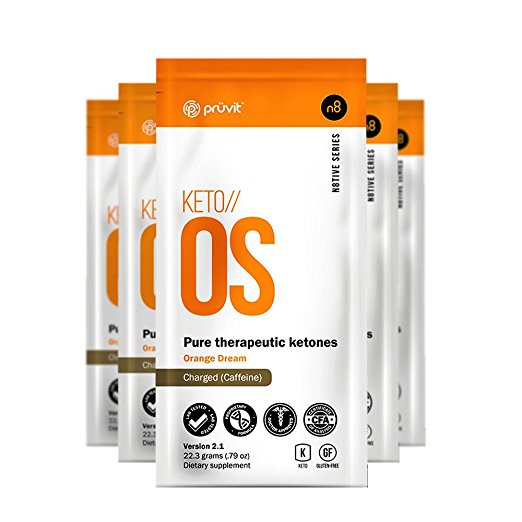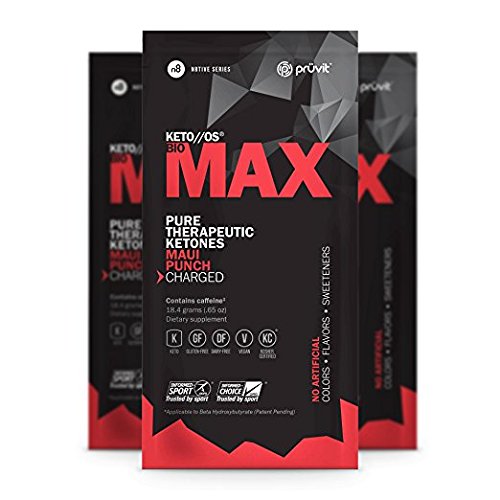There are a ton of fad diets out there, and quite frankly, most of them are not what they're advertised to be.
I've experimented with many of these diets on my own to test out what works for me, and identify which philosophies made the most sense to me from a biochemical standpoint.
Among all of the many diet philosophies out there; Atkins/Modified Atkins, Paleo, Vegan, Fruitarian, Alkaline, etc, the one that has stood out to me the most is the ketogenic diet.
Here I discuss the details of the diet, include some of the science surrounding it's health claims, and a brief description of the biochemistry taking place in those following this diet philosophy.
As with anything, I encourage everyone to do their own research, and to remain skeptical. This is meant to serve as a starting point for those interested in delving deeper into the ketogenic diet.
What Is The Ketogenic Diet?
The ketogenic diet is designed to condition the body to use ketone bodies (from fat) as a primary source of fuel rather than glucose (from carbohydrates).
Achieving this involves eating roughly 70% of the total daily calorie intake in the form of fat, and cutting proteins and carbohydrates down to 25% and 5% of the daily calorie intake respectively.
The goal of a ketogenic diet is to achieve a state of metabolic ketosis. The idea is that this essentially allows us to tap into a larger fuel tank (fat reserves) to supply more consistent energy levels throughout the day. It also allows for easy breakdown of fat stores for energy, making it easier to lose weight.
Cellular Energy Substrates
There are 2 groups of molecules the body uses as a substrate for energy production:
1. Sugars
Carbohydrates and complex sugars are absorbed from the digestive tract and converted to simple sugars (glucose and fructose). Insulin is then secreted into the bloodstream to shuttle sugars into the cells where they are converted into energy.
When blood glucose dips, stored glucose is broken down from glycogen in the muscles and liver.
1. Ketones
Ketones are released during a fasted state to provide energy to the cells in the abscence of glucose. They are made from our dietary fats, as well as stored fats.
Unlike sugars, fats are not water soluble, and therefore cannot be released into the bloodstream in their raw forms. The liver converts stored fat to water soluble ketones such as acetoacetate and beta-hydroxybutyrate.
These ketones then travel throughout the body to be used as a substrate for energy production. They can enter the cells diectly without the need for insulin.
Understanding Macronutrients:
There are 3 main macronutrients the body needs to survive, carbohydrates, proteins, and fats.
Carbohydrates
Carbohydrates can be thought of like rocket fuel. They're converted into glucose in the digestive tract and absorbed into the bloodstream quickly. The energy from carbohydrates (especially simple carbohydrates) provide a lot of energy quickly, but tends to need refueling often to avoid crashing.
Proteins
Proteins can be thought of as the building blocks for the body. We break proteins down into their smallest pieces, amino acids, before absorbing them into the bloodstream. Our body then uses these proteins to build new cells, enzymes, hormones, and neurotransmitters. We can also convert proteins into glucose for energy, although this takes more time and energy investment to do, so the body only does this when glucose isn't readily available.
Fats
Finally, we have fats, which are the basis of the ketogenic diet. Fats can be thought of as lumps of coal. They are a dense store of energy, which can be released more slowly over time. We rely on fats for energy during times of starvation. Instead of converting to glucose, however, fats are turned into a group of chemicals known as ketones.
Why Choose The Ketogenic Diet?
Blood glucose spikes after a meal
Many people choose the ketogenic diet for medical reasons (more on this below) such as manageing diabetes, multiple sclerosis, or Alzheimer's disease.
Others use it as part of a cognitive enhancement regimen, to improve athletic endurance, or to lose weight.
Perhaps the main reason people choose the ketogenic diet is to manage energy levels.
With carbohydrate-adapted metabolism, blood glucose tends to spike directly following a meal. The body responds to this by inreasing insulin levels to shuttle these sugars into the cells. If we have more glucose than we do energy requirements, this excess glucose is converted to fat. Additionally, insulin inhibits the breakdown of fat, making it difficult to retrieve energy from fat stores. This results in spikes in energy after meals, followed by crashes soon after.
Benefits of Ketosis:
- More stable energy levels throughout the day
- Lowered insulin resistance
- Decreased body fat (calorie dependant)
- Less hunger
- Improved cognitive performance
- Better focus and concentration
- Reduced epilepsy symptoms
Keto-adapted metabolism, on the other hand, has a much slower breakdown and absorption into the blood stream, allowing the energy-dense fats to absorb slowly over time.
Additionally, keto-adapted metabolism involves low insulin levels, allowing the breakdown of fat to occur freely.
This allows fat to support periods of low dietary energy intake much more seamlessly than glucose. This is why one of the key features of keto-adaptation is low appetite, even after 10 to 16 hours of fasting.
Ketones are more efficient as a source of energy than sugars. In fact, ketones will produce roughly 10% more energy than an equivelent weight of glucose [13].
Research For Keto-Adaptation
Weight Loss
Traditional Diet
With traditional, high carb diets, fat burning only happens after all of our blood sugar and glycogen reserves have been used up. Excersise increases our bodies demand for energy, which it responds to by dumping more glucose into the blood from glycogen. When we excercise, we need to work for as long as 90 minutes with low intensity excercise, or 20 minutes of high intensity in order to deplete this glycogen. Only after this point will we begin burning fat for energy.
Ketogenic Diet
Despite what you might think, eating fat doesn't make you gain fat. When we eat fat, we easily store excess energy in the form of fat, however, we also break it apart easily through an enzyme known as lipase. This enzyme is tasked with releasing fat into the bloodstream from the adipocyte storage cells.
When we are in ketosis, a careful control of our calorie intake makes it very easy to lose weight by converting stored fat to ketone bodies to use for energy, and makes our excercise routines more efficient because our bodies already begin breaking down fat for energy when demand increases.
Some Research
A meta analysis comparing the effeciveness of a high fat (ketogenic) diet versus a high carb diet found that those on the high fat diet had the best long-term weight reduction scores [1].
Improved Focus & Concentration
The keto-adapted brain is thought to be more efficient than its carb-fueled counterpart. This idea comes from a series of studies showing that increased concentrations of certain ketone bodies (D-β-hydroxybutyrate) stimulated an increase in BDNF (important contributor in the process of learning and memory) [2].
+ Neuroprotection
The ketogenic diet has been shown to produce a variety of neuroprotective mechanisms, tested on conditions ranging from Alzheimer's disease, epilepsy, Parkinson's disease, multiple sclerosis, traumatic brain injury, and stroke.
Ketones are a more efficient source of energy for the brain than sugar. One study showed a gradual decrease in the brains ability to metabolise glucose with age (seen through glucose transport systems) [3]. Other studies have noted the benefits of having a more efficient energy source in states of traumatic or hypoxic injury [6].
This suggests that the ketogenic diet may be beneficial for preventing the symptoms of age-related cognitive decline. This may explain a mechanism of action for the diets positive impact on conditions like Alzheimer's disease [4], Parkinson's disease [5], multiple sclerosis [7], traumatic brain injury [8], and epilepsy [9].
How Does Ketosis Work?
Metabolic ketosis involves an upregulation of processes related to fat breakdown (lipolysis) and mobilisation into the cells for energy. Fat contained in the fat storage cells (adipocytes) are converted from triglycerides to fatty acids, then into acetyl-coA (through beta-oxidation). These molecules are then converted into ketone bodies like Acetoacetate and 3-hydroxybutyrate in the liver.
Stored Fat (Triglycerides)
Free Fatty Acids
Acetyl-CoA
Ketones (Converted in the liver)
Ketones are released into circulation from the liver because the liver is unable to use these ketones for itself. (It lacks the mitochondrial enzyme succinyl CoA:3-ketoacid CoA transferase required for activation of acetoacetate back to acetoacetyl CoA [10]).
These ketones are then released into the blood to supply cells throughout the body with energy.
Although the body can convert protein to glucose through a process called gluconeogenesis, this process is undesired. This is because in order to supply the brain with the required 110-120g of glucose, roughly 160 to 200 g of protein (close to 1 kg of muscle tissue) needs to be broken down [11].
In order to prevent this from happening, the body is well adapted to begin using fats through ketosis when faced with low glucose availability. It does this in order to reduce the need to convert proteins to glucose instead, resulting in muscle wasting.
How Long Does It Take To Achieve Keto-Adaptation?
There are varying levels of ketosis. Early stages begin after about 2 days of hypoglycemia (low blood glucose). The body will become weak and energy deficient, gluconeogenesis increases to convert proteins to glucose, and lipolysis will begin to release acetyl-coa into the bloodstream towards the liver. The liver then converts this into ketones like acetoacetate.
After about a week, this process becomes increasingly efficient, and most people will reach a state of mild keto-adaptation by this point.
True keto-adaptation is considered to be between 1.5 and 3 mmol ketones per L of blood. This can take between 3 weeks, and 3 months, depending on the carbohydrate and protein intake. Genetic factors (such as PPARα and APOE variations) also play a role here, with some genetic variants allowing ketosis more readily than others.
Traditional Diet
Glucose Levels Fall
Pancreas secretes insulin
Insulin moves glucose into the cells
The cells produce energy
Ketogenic Diet
Blood glucose levels drop
Lipase releases fatty acids from fat
Liver converts fat to ketones
Ketones enter the cell to produce energy
Ideal Macronutrient Distribution
Energy intake distribution in %
Measuring macronutrients is the basis for the ketogenic diet. The ideal target for most people is to have about 5-10% of their total energy intake in the form of carbohydrates, 20-25% from proteins, and the rest from fat.
Energy in kJ per g
Fat Is High Energy
Fat contains roughly double the energy per gram than carbohydrates and proteins, it’s fairly easy to achieve this macronutrient distribution through the addition of vegetable and animal fats to meals.
Measuring Ketosis
Ketosis is best measured by how you feel on the diet. Most people are able to tell when their body is in ketosis based on variations in their energy and hunger levels.
To measure ketosis with biometrics, testing ketone levels in the blood or urine can be done using urine dip sticks, or blood ketone sensors.
Optimal ketosis is considered to be within the range of 1.5 and 3 mmol/L of ketone bodies.
What Can I Eat?
- Butter
- Vegetable oils
- Nuts, seeds, legumes
- Coconut oil
- Palm oil
- Non-root vegetables
- Avocado
- Beef
- Chicken
- Fish
- High fat cream
- Hard cheese
- Bone broth
- Eggs
The keto food pyramid
What Can't I Eat?
- Oats
- Grains
- Soda
- Candy
- Fruit juices
- Alcohol
- Root vegetables
Tips For Getting In To Ketosis:
1. Restrict Carbohydrate Intake
Limiting carbohydrate intake is a central component of reaching a state of ketosis. The body needs to experience a reduction in available blood glucose for an extended period of time before it triggers ketosis.
- Shoot for 5-10% of your daily energy intake in the form of carbohydrates. The average male should shoot for roughly 15-20g of carbohydrates per day and the average woman should aim for around 10-15g/day.
2. Restrict Protein Intake
One of the most commonly overlooked mistakes those new to the ketogenic diet make is forgetting to also limit their protein intake. This is because proteins are converted to glucose when levels begin to diminish in the blood. High protein intake can prevent the body from reaching ketosis.
- Ideal protein intake can vary a lot from person to person. Athletes may need to consume more protein in a day. Males also tend to require more protein per day than females. The general rule of thumb is to consume no more than 25% of your daily energy requirements in the form of protein.
3. Drink Plenty of Water
- One of the major steps in metabolic ketosis is beta-oxidation. This step requires water as a source of oxygen.
4. Experiment With Fasting
Fasting is essentially simulated states of temporary starvation. It goes a long way towards promoting ketosis because it simulates the exact scenarios that this system was intended for in the human body.
- There are 2 main philosophies involved with fasting. Daily fasting involving a 6-8 hour window where food can be consumed, or a weekly or monthly extended fast lasting a few days (when safe to do so).
5. Kill Your Old Opinions About Fats
For the last 20 years it's been engrained in us that fats are bad. We now know this isn't the case, and it's the basis for the energy source of those on the ketogenic diet. You need to ensure that you're eating enough of this fat on a daily basis to meet your daily energy requirements.
6. Use Supplements To Give Ketosis a Boost
This isn't required, but can go a long way towards pushing the body into ketosis faster, as well as reducing the side effects of transitioning into ketosis.
- There are a number of supplements you can use to promote ketosis, including caffeine, exogenous ketones, MCT oil (medium chain triglycerides).
Potential Side Effects:
The ketogenic diet has some side effects, especially in the early stages as we force our bodies to transition from glucose to ketone based metabolism. At first your body will demand glucose, and as we limit the intake of glucose the cells begin to starve.
You may experience the following in the early stages of keto-adaptation:
- Fatigue
- Difficulty sleeping
- Bad breath
- Muscle cramping
- Constipation

Author Bio:
Justin Cooke is a medical herbalist, and the founder of The Sunlight Experiment. He has a passion for scientific research and discovery is what motivates him to produce content like this everyday.
He earned a Bachelor of health sciences (BHSc) degree in 2018, and currently writes for a number of prominent health and medical blogs.
View ProfileRecent Blog Posts:
References
- Bueno, N. B., de Melo, I. S. V., de Oliveira, S. L., & da Rocha Ataide, T. (2013). Very-low-carbohydrate ketogenic diet v. low-fat diet for long-term weight loss: a meta-analysis of randomised controlled trials. British Journal of Nutrition, 110(7), 1178-1187.
- Sleiman, S. F., Henry, J., Al-Haddad, R., El Hayek, L., Haidar, E. A., Stringer, T., ... & Ninan, I. (2016). Exercise promotes the expression of brain derived neurotrophic factor (BDNF) through the action of the ketone body β-hydroxybutyrate. Elife, 5.
- Ding, F., Yao, J., Rettberg, J. R., Chen, S., & Brinton, R. D. (2013). Early decline in glucose transport and metabolism precedes shift to ketogenic system in female aging and Alzheimer's mouse brain: implication for bioenergetic intervention. PloS one, 8(11), e79977.
- Van der Auwera, I., Wera, S., Van Leuven, F., & Henderson, S. T. (2005). A ketogenic diet reduces amyloid beta 40 and 42 in a mouse model of Alzheimer's disease. Nutrition & metabolism, 2(1), 28.
- Vanitallie, T. B., Nonas, C., Di Rocco, A., Boyar, K., Hyams, K., & Heymsfield, S. B. (2005). Treatment of Parkinson disease with diet-induced hyperketonemia: a feasibility study. Neurology, 64(4), 728-730.
- Calorie sources and recovery from central nervous system ischemia. Cherian L, Peek K, Robertson CS, Goodman JC, Grossman RG Crit Care Med. 1994 Nov; 22(11):1841-50.
- Hao, J., Liu, R., Turner, G., Shi, F. D., & Rho, J. M. (2012). Inflammation-mediated memory dysfunction and effects of a ketogenic diet in a murine model of multiple sclerosis. PloS one, 7(5), e35476.
- Gasior, M., Rogawski, M. A., & Hartman, A. L. (2006). Neuroprotective and disease-modifying effects of the ketogenic diet. Behavioural pharmacology, 17(5-6), 431.
- Vining, E. P., Freeman, J. M., Ballaban-Gil, K., Camfield, C. S., Camfield, P. R., Holmes, G. L., ... & Wheless, J. W. (1998). A multicenter study of the efficacy of the ketogenic diet. Archives of neurology, 55(11), 1433-1437.
- Zarrin, M., De Matteis, L., Vernay, M. C. M. B., Wellnitz, O., van Dorland, H. A., & Bruckmaier, R. M. (2013). Long-term elevation of β-hydroxybutyrate in dairy cows through infusion: Effects on feed intake, milk production, and metabolism. Journal of dairy science, 96(5), 2960-2972.
- Watford, M., & Goodridge, A. G. (2000). Regulation of fuel utilization. Biochemical and physiological aspects of human nutrition. Philadelphia, PA: WB Saunders Company, 384-407.
- Salway, J. G. Metabolism at a glance. 1999.



















